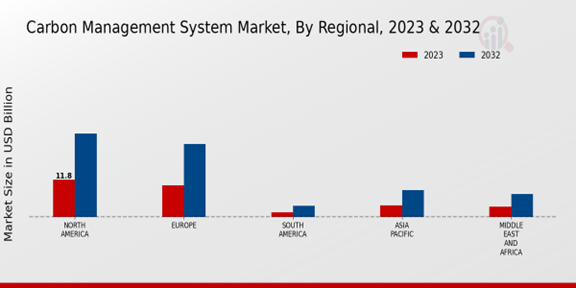Growing Public Awareness
Public awareness regarding climate change and environmental sustainability is increasingly influencing the Global Carbon Management System Market Industry. As consumers become more informed about the impacts of carbon emissions, they are demanding greater transparency from companies regarding their environmental practices. This heightened awareness is prompting organizations to adopt carbon management systems to demonstrate their commitment to sustainability. For instance, brands that actively engage in carbon reduction initiatives often enjoy enhanced customer loyalty and market differentiation. As a result, the demand for effective carbon management solutions is likely to rise, further propelling the market's growth.
Market Growth Projections
The Global Carbon Management System Market Industry is poised for substantial growth, with projections indicating a market size of 38.9 USD Billion in 2024 and an anticipated increase to 101.9 USD Billion by 2035. This growth trajectory reflects a compound annual growth rate (CAGR) of 9.15% from 2025 to 2035. Such projections underscore the increasing importance of carbon management systems as organizations strive to meet regulatory requirements, enhance sustainability efforts, and respond to consumer demands for transparency. The market's expansion is indicative of a broader shift towards sustainable practices across various industries.
Technological Advancements
Technological advancements play a pivotal role in shaping the Global Carbon Management System Market Industry. Innovations such as artificial intelligence, machine learning, and blockchain are enhancing the efficiency and accuracy of carbon tracking and reporting. For instance, AI-driven analytics can optimize energy consumption and identify emission reduction opportunities. These technologies not only streamline operations but also provide organizations with actionable insights to improve their carbon management strategies. As companies increasingly adopt these advanced technologies, the market is likely to experience significant growth, driven by the need for more effective carbon management solutions.
Investment in Renewable Energy
The transition towards renewable energy sources is a significant driver in the Global Carbon Management System Market Industry. As countries commit to reducing their reliance on fossil fuels, investments in solar, wind, and other renewable technologies are surging. This shift necessitates the integration of carbon management systems to monitor emissions associated with energy production and consumption. For example, countries like Germany and Denmark are leading the way in renewable energy adoption, which in turn fuels the demand for carbon management solutions. This trend is expected to bolster the market as organizations seek to align their operations with sustainable energy practices.
Regulatory Compliance Pressure
The Global Carbon Management System Market Industry is increasingly influenced by stringent regulatory frameworks aimed at reducing greenhouse gas emissions. Governments worldwide are implementing policies that mandate organizations to monitor and report their carbon footprints. For instance, the European Union's Emissions Trading System has set ambitious targets for emission reductions, compelling companies to adopt carbon management solutions. This regulatory pressure is expected to drive the market's growth, as organizations seek to comply with these regulations and avoid penalties. As a result, the Global Carbon Management System Market is projected to reach 38.9 USD Billion in 2024, reflecting the urgency for compliance.
Corporate Sustainability Initiatives
In the Global Carbon Management System Market Industry, corporate sustainability initiatives are becoming a primary driver of market growth. Companies are increasingly recognizing the importance of sustainable practices not only for compliance but also for enhancing their brand reputation. For example, major corporations are committing to net-zero targets, which necessitates the implementation of robust carbon management systems. These initiatives are often supported by stakeholders and investors who prioritize sustainability. Consequently, the demand for carbon management solutions is expected to surge, contributing to a projected market size of 101.9 USD Billion by 2035, with a CAGR of 9.15% from 2025 to 2035.


























